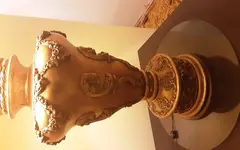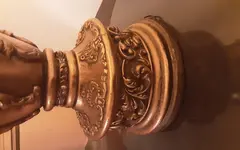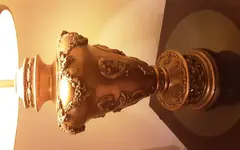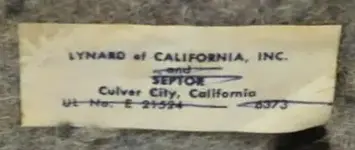I thought a lot about this before replying. This history of this pair/partnership of two companies seems to be very poorly documented. There is a record of a patent (for a futuristically styled lamp) being filed in 1953, which was granted in 1956. It was filed by William Rosenthal as inventor and assigned to Lynard of California, Inc but with no mention of the company ‘Septor’. The patent is here:
https://patentimages.storage.googleapis.com/e2/35/99/fbf992345be501/USD170772.pdf
Doubtless you will have seen some of their lamps popping up on auction sites with dating said to be 1950s/1960s and they mostly seem to be in the modern style using organic materials such as carved wood, cork and stone; or in futuristic styles and materials of the kind we regard as design icons today. Accordingly, those latter ‘statement’ pieces seem to be extremely collectable, with prices range from ‘high’ to ‘exorbitant’.
I’m left with the impression that their lamps were largely hand-made in artisan premises in limited numbers for a relatively short number of years and probably sold in swanky home décor stores. Maybe not nationally. Maybe Lynard supplied the artistic elements and Septor took care of the electrical fitments?
There seems to be nothing one could describe as in ‘classical’ style that resembles your very Grecian-urn-looking lamp. It doesn’t seem to have been their thing, which makes me a little suspicious. Does your lamp have a paper label stuck on the bottom, like the one below?
View attachment 1866213
If so, I have an uneasy feeling that the label has been purloined from a Lynard & Septor lamp… or perhaps found loose and mistakenly stuck onto a lamp to which it didn’t originally belong.
The serial number ‘UL NO. E 21524-6373’ doesn’t help. UL numbers relate to ‘Underwriter Laboratories’ of Illinois, who provide certifications for safety purposes that are internationally recognised (in 46 countries). E 21524 is a set of electrical standards for internal wiring or external connection of electrical equipment and still in force under that number today.
Interesting that on the label I showed above (from a known Lynard & Septor lamp) the words “and Septor” plus the electrical safety certification numbers are crossed out. My guess is that this was done by an auction house or secondhand seller who isn’t accepting liability for a certification originally obtained by Septor (hence my belief that Septor took care of the electrical fitments). I don’t know about the States but, over here, the secondhand sale of items that are legally required to meet certain safety requirements presents difficulties for a re-seller unless the item has been re-certified.








